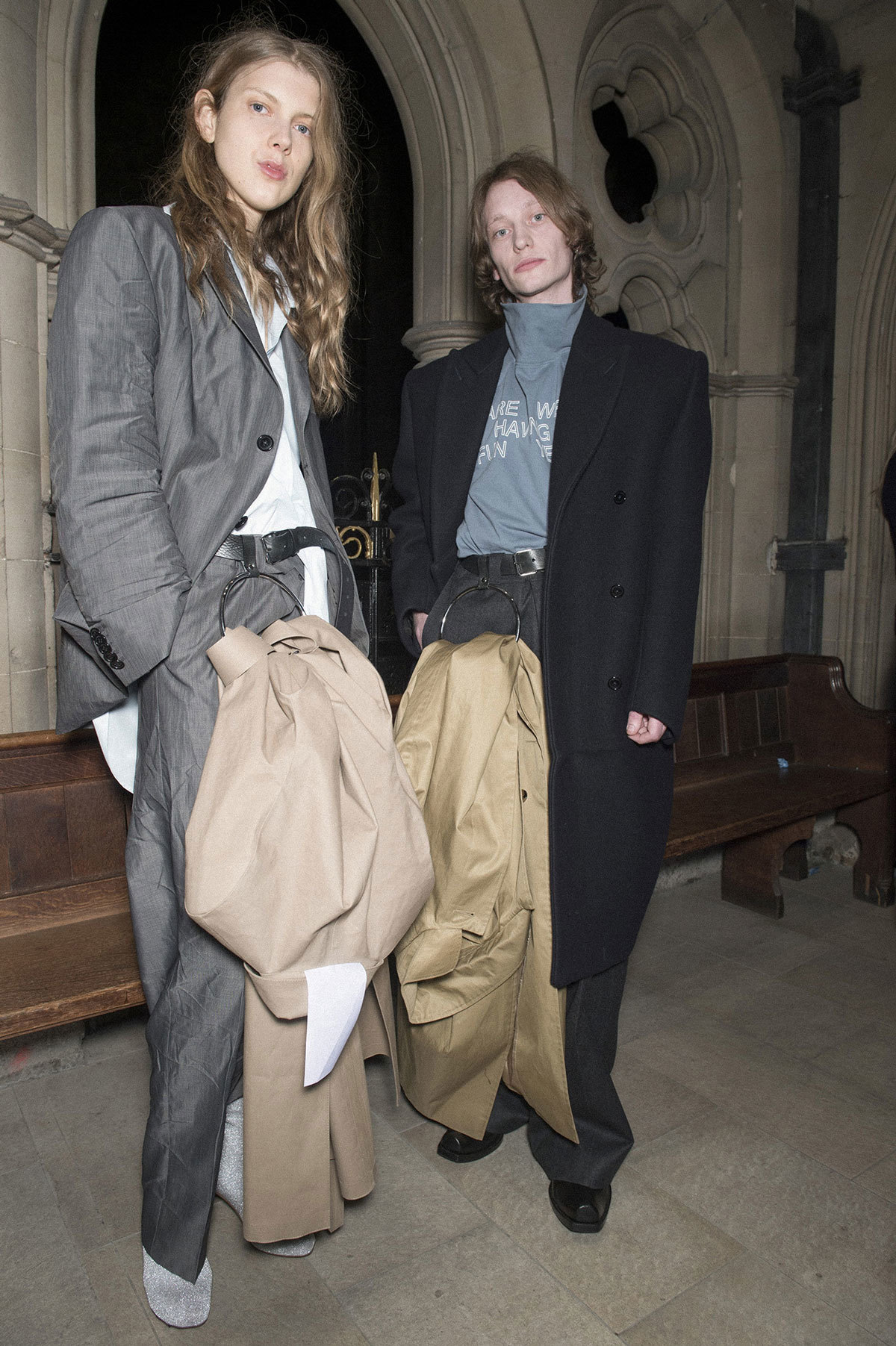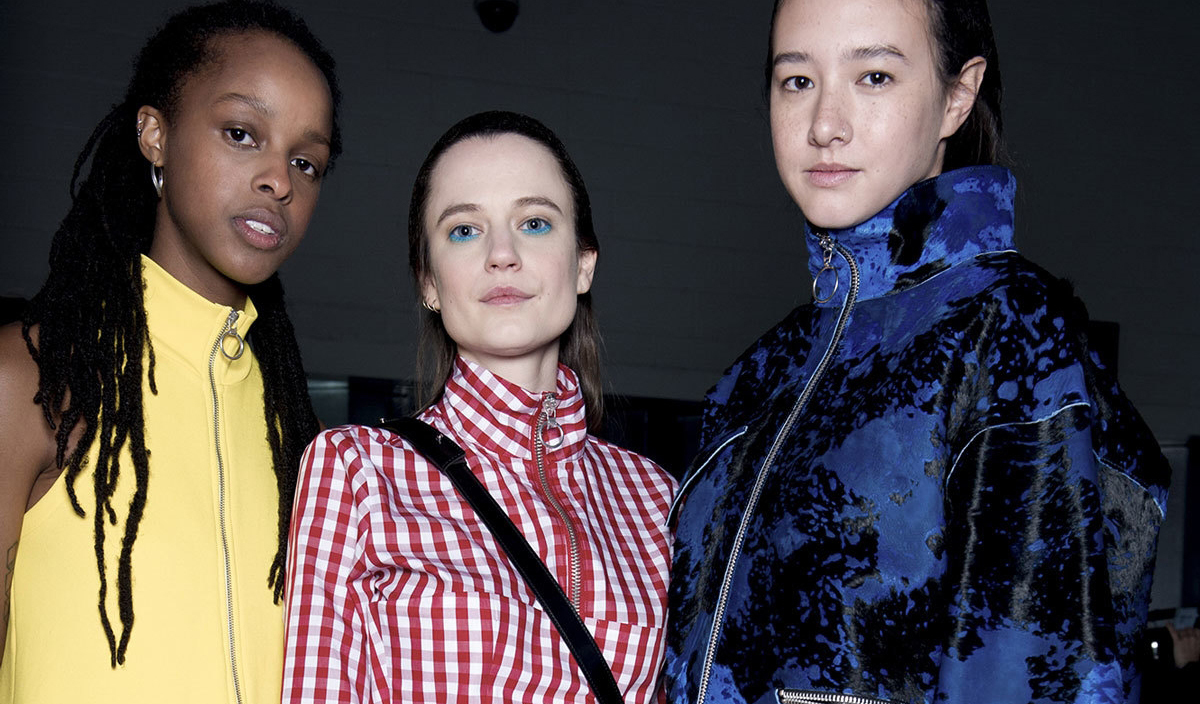With an absence of excitement at the top of the fashion pyramid — Dior and Lanvin without creative directors, rumors percolating about Phoebe, Hedi et al jumping ship from established houses — perhaps it’s no surprise that this season there’s been renewed focus on younger, less established talents. In particular, those who’ve made their mark have done so through innovative casting — less models, more people who look like us.
New York, not always known for directional fashion, set the tone. Eckhaus Latta’s show at PS1 was one of the highlights of the week, if not the month. Under the geodesic dome, a characterful selection of models and friends of the bi-coastal design duo paraded in their creations. The casting reinforced the tactile nature of Mike Eckhaus and Zoe Latta’s designs, crushed golden velvet rubbing up against stretch knits. “Touch this skin — it’s no different from yours,” it seemed to say. It was also notably diverse, another way of saying the casting embraced a multiplicity of genders, ages and races; transgender artist Juliana Huxtable was followed by architect Miggi Hood. Combined with the design duo’s wonderfully mismatched, oddly-knitted garments, the overall effect was one of great warmth and energy, miles away from the clinical glamour so often seen on the runway in New York.
While Eckhaus Latta delivered a modern kind of serenity, the Vaquera show was a different beast altogether, wild and youthful. The label, started by Patrick DiCaprio in his bedroom, now combines his talents with those of David Moses (ex of Moses Gauntlett Cheng, the much Instagram’d trio), and visual artist Bryn Taubensee. The show took place at China Chalet, and was reminiscent of Malcolm Mclaren’s Bow Wow Wow — think then-teenage lead singer Anabella Lwin in faux Marie Antoinette flounces. Just as Lwin once sung, “I feel sexy, sexy Eiffel towers,” the once again friend-cast models were sexy in a sort of random, ridiculous way: French kissing, giving sloppy lap dances, and putting their cigarettes out in drinks — all with extra erect nipples which had been rubbed with ice. It was all so fabulously amateurish you could help but smile (or shriek — there was lots of shrieking). But once again, you believed the designers’ proposition — real, if ridiculous clothes that the people who were modeling would love to wear.

Across the Atlantic, Molly Goddard was similarly concerned with great flounces of fabric. Her design signature is now eminently recognizable – swathes of gorgeously colored pleated tulle. What keeps it from becoming a princess fantasy nightmare are her innovative and impeccably cast presentations. Last season her models assembled in a giant sandwich factory she’d created, and for fall/winter she created a surreal set inspired by the ’60s cult favorite Tokyo Drifter. Fittingly, the film’s about gangs, just as Goddard’s so recognizably created hers. Her models, while still sample size, are a little more womanly than the norm, cleverly anchoring her whispy creations and making you think you could wear them. Once again, believable.
Claire Barrow’s presentation was similarly surreal, but while Goddard’s maidens were beings of the daytime, Barrow’s illustrated creatures that scrawled across her garments were most definitely of the night. Barrow created an art exhibition at the ICA titled “the Retro-Spective”, tongue firmly stuck out at the people who insist on asking if she’s an artist or designer. The models shared her clothing’s off kilter beauty, coming in an array of sizes — a statuesque boy with a shaved head in a gown next to a petite girl in white knickers over painted tights. The collection’s accompanying films were also “friend made,” with 13-year-old Duke Brooks filming her painting at Elms Lesters’ painting rooms, while Alice Neale filmed Frank LeBon reciting a Coleridge poem. It felt chaotic — a refreshingly authentic approach to fashion when London’s become so slick.
Slick however isn’t always bad, as is the case with Marques’Almeida. The duo, who found fame with the frayed denim that’s been pounced upon by the fashion pack, counterbalanced their joyously polished and eclectic show with a brilliantly cast show of friends (two of whom are i-D editors) intermixed with models. Somehow it gave their collection voice – why shouldn’t the label that’s found so much appreciation on the street be worn by those people on the runway too?

Of course, designers putting their friends in their shows isn’t new — it’s just that it’s become increasingly less authentic. There was a naïve joy to Marc Jacobs fall/winter 10 show for instance, that saw his friends and collaborators Camille Bidault-Waddington and Susanne Deeken walking. Rick Owens has used the same bunch of angular models and friends repeatedly. Nicholas Ghesquiere has dressed the same austere group of women off the runway for years, amongst them Charlotte Gainsbourg and Maggie Cheung. What feels less authentic are the shipped-in kids who allegedly a designer has hand picked, probably from LA, or the designers who have to talk about their #hashtag #gang.
This being fashion, Paris has of course had the last word. Vetements is designed by an actual gang helmed by Demna Gvasalia, so perhaps it’s no surprise that its show is so particularly cast, its friends sharing an Eastern European look and attitude. He carried across this spirit to the venerable house of Balenciaga, where Clara Deshayes, who created the show soundtrack also walked the show, alongside artist Jane Mosely (the fabulously named @oodlesofpain on Instagram). Rather than seeming punk, the casting enforced the modern chic of the show — interesting women wearing interesting clothes.
This is perhaps the essence of the new wave of castings — we’re supposed to aspire to look like models in their clothes, but frankly, the blonde and blue eyed are a minority amongst high fashion clients, and about as characterful as a pint of milk. How much more exciting to see a show filled with people who look like you, even if it is you on an exceptionally good day.
Credits
Text Jack Sunnucks
Photography Jason Lloyd Evans
